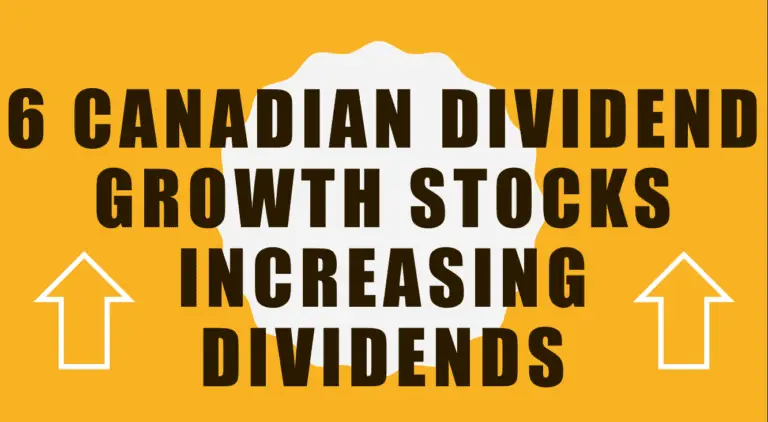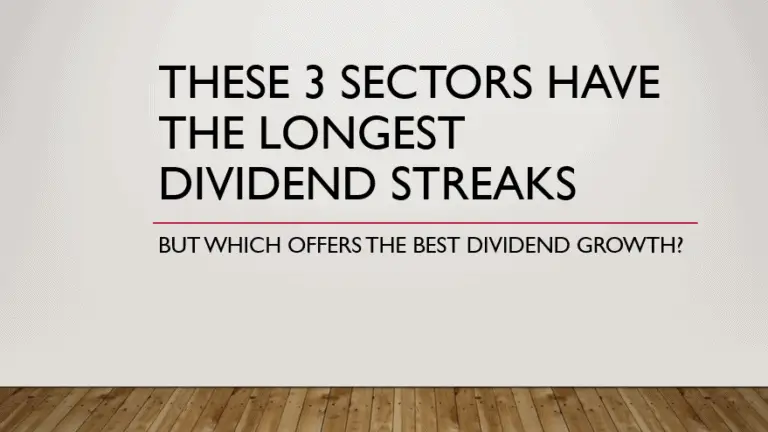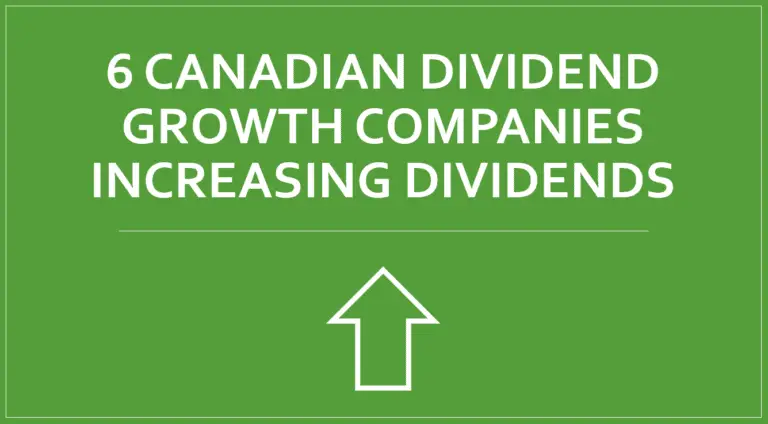Dividend Growth Investing & Retirement is supported by its readers through donations and affiliate links. If you purchase through a link on my site, I may earn a commission. Thanks! Learn more.
I’ve now gone through and made some notes on what all the column headers mean in the Canadian Dividend All-Star List. This information will be included in the Notes tab of the All-Star List download at the end of the month. Here’s the information:
Seq
The ranking of companies based on the length of their dividend streak. The closer it is to the number one the longer the streak. Fortis Inc currently has the longest streak for Canadian companies with a dividend streak of 39 years in a row. It’s ranked #1
Ticker
The Yahoo! Finance stock ticker used to identify the company.
Company
The name of the company.
Streak
The number of consecutive calendar years the company has increased their regular dividend. I’ve removed special dividends when determining the streak. For instance if a company pays out a one time special dividend on top of their regular dividends that results in a higher dividend in the previous year they will not be penalized because of this. I’m only focusing on the increases of regular dividends. I’ve used the record date based on a calendar year to determine the streak length. There are a variety of different key dividend dates that occur (record date, payable date, ex-date, and declared date). Because of the timing differences between these dates it is possible for a company to have a longer or shorter dividend streak based on the payable date, but not on the record date. This is just one example, but it is something to be aware of. I have used the record date based on a calendar year (January-December) to determine streak lengths.
Other Notes: If the company initiated a dividend I count that as an increase. For instance if a company was not paying a dividend and then start this year, their streak would be 1. The dividend streaks are updated annually at the end of the calendar year.
DRIP Fees – DR
If there is a dividend reinvestment plan (DRIP) this will tell you if the plan has fees or not. If the plan has fees it will be a “Y”. If the plan doesn’t have fees it will be an “N”. If there is no DRIP it will be “n/a”.
DRIP Fees – SP
If there is a share purchase plan (SPP) this will tell you if the plan has fees or not. If the plan has fees it will be a “Y”. If the plan doesn’t have fees it will be an “N”. If there is no SPP it will be “n/a”.
Price
The stock price. This information is taken from Yahoo! Finance.
Yield
The dividend yield is calculated by taking the most recent dividend multiplying it by the relevant factor (4 -quarterly dividend, 2- semi-annual, 12 – monthly, etc) to get an annual dividend amount. The annual amount is then divided by the stock price to get the dividend yield.
Everyone has their own investing style, but I generally like to invest in companies with a dividend yield that ranges from 2.5% to 6.0%. I’ll consider going down to 2.0% if I expect the company to continue a trend of high dividend growth. Generally a yield higher than 6% for a public company is a warning sign from the market that the dividend may be unsustainable. I’m not saying I won’t invest in companies with yields higher than 6%, but it’s important to be skeptical of the sustainability of high dividend yields.
Dividend – Old
The dividend amount before the most recent increase. The dividend amount will be the quarterly, monthly, semi-annual, or annual dividend depending on the company. For instance if the company pays out regular quarterly dividends the amount shown would be the quarterly dividend amount before the most recent increase. If the company has changed the frequency it pays out dividends this value will be adjusted to reflect the new dividend schedule. For instance if a company paid out an annual dividend of $4.00 and then switched to a quarterly dividend the old dividend value would be adjusted to $1 ($4/4). This is so that dividend increases can be calculated correctly.
Dividend – New
The most recent dividend amount. The dividend amount will be the quarterly, monthly, semi-annual, or annual dividend depending on the company. For instance if the company pays out regular quarterly dividends the amount shown would be the most recent quarterly dividend.
% Inc.
The most recent dividend increase shown as a percentage (%).
Qtly Sch
The dividend schedule based on dividend record dates.
Quarterly Schedules:
A – January April July October
B – February May August November
C – March June September December
Other Schedules:
M – Monthly
S – Semi-annual
WARNING: I’ve made my best effort to present these schedules accurately, but sometimes an event happens in the year and one of the dates is moved up or down a month. Another common problem is some companies will have a record date at the end of a month, but if it falls on a weekend the date is changed to the first business day of the next month. Because of these difficulties, I’d use this column as a guideline, but I wouldn’t expect 100% accuracy.
Notes
This column is used to for additional notes. The type of notes could be anything, but a common one will be if the company pays out it’s dividend in US dollars (USD). This type of information is disclosed here along with other notes.
Annual Dividend
The annual dividend is calculated by taking the most recent dividend multiplying it by the relevant factor (4 -quarterly dividend, 2- semi-annual, 12 – monthly, etc) to get an annual dividend amount.
Payout Ratio %
The payout ratio is the annual dividend divided by the earnings per share (EPS). This ratio is used by investor to get an idea if the dividend payments are sustainable.
For example a payout ratio of over 100% means that the company is paying out more money in dividend than it is earning. With a ratio over 100% a company has to use other means to pay the dividend. Some of these other means could include taking on debt, using existing cash balances, etc.
Acceptable payout ratios vary by industry but I generally like to see a payout ratio of 60% or less. This allows for some room for dividend growth and the company can use part of the other 40% to fund company growth initiatives. For utilities and telecoms I allow a slightly higher payout ratio.
+/-% vs. Graham
This a method of valuing a stock that uses the book value and EPS of the company. The method was created by Benjamin Graham who is a famous value investor.
The formula to calculate the Graham price is the square-root of (22.5 x Book Value x EPS). In this column I show how far off the stock price is from the calculated Graham price as a percentage. For instance if the Graham price was $100 and the stock price was $125, then the column would show the value as 25% which is how much higher the stock price is from the Graham price. If the stock price was below the Graham price the percentage would be negative.
TTM P/E
The Trailing Twelve Month (TTM) Price to Earnings (P/E) ratio. This is a valuation ratio that is calculated as the stock price divided by earnings per share (EPS).
For Canadian stocks I generally want to see this ratio at 15 or less, the lower the better.
EPS
Earnings Per Share (EPS) taken from Yahoo! Finance.
5 Yr Expected PEG
The 5 year PEG ratio (price/earnings to growth ratio) taken from Yahoo! Finance. This ratio takes the P/E ratio and divides it by the expected annual growth rate for the next five years. The PEG ratio is used to determine the trade-off between the stock price, EPS, and expected growth.
WARNING: Always be skeptical of estimates, especially those that look a long ways into the future like a 5 year estimate. A lot can change in 5 years.
TTM P/Sales
The Trailing Twelve Month (TTM) Price to Sales (P/Sales) ratio taken from Yahoo! Finance.
MRQ P/Book
The Price to Book ratio using the Most Recent Quarter’s (MRQ) book value. This information is taken from Yahoo! Finance.
TY Est EPS
This year’s (TY) estimated earnings per share (EPS) taken from Yahoo! Finance.
NY Est EPS
Next year’s (NY) estimated earnings per share (EPS) taken from Yahoo! Finance.
NY% Growth
Next year’s (NY) estimated EPS growth as a percentage (%). This is calculated as the percentage increase or decrease of the Next Year (NY) EPS estimate compared to This Year’s (TY) EPS estimate. This formula is calculated using data from Yahoo! Finance.
Est 5-yr Growth
This is the average annual EPS growth rate expected for the next 5 years. This is a calculation to get the growth rate used in the 5 Yr Expected PEG which is taken from Yahoo! Finance.
WARNING: Always be skeptical of estimates, especially those that look a long ways into the future like a 5 year estimate. A lot can change in 5 years.”
MktCap
The market capitalization taken from Yahoo! Finance. Market capitalization is the total value of issued shares. It’s equal to the share price times the number of shares outstanding.
52-wk Low
The percentage off of the 52 week low price. This information is taken from Yahoo! Finance.
52-wk High
The percentage off of the 52 week high price. This information is taken from Yahoo! Finance.
Year Range
The trading range for the past year. It shows the 52 week low and high stock price as a range. This information is taken from Yahoo! Finance.
50-day MA
Percentage (%) off the 50 Day Moving Average (MA).
200-day MA
Percentage (%) off the 200 Day Moving Average(MA).
5/10 A/D
This takes the 5 year dividend growth rate and divides it by the 10 year dividend growth rate. This is meant to give you an idea of whether dividend growth rates are increasing or decreasing over time. A value over 1.0 suggests that the dividend growth rate has been increasing as the 5 year rate is higher than the 10 year rate. A value under 1.0 suggests the dividend growth rate has declined compared to the 10 year average. A value that is 1.0 suggests that the 5 and 10 year dividend growth rates have remained the same.
Dividend Growth 1-yr
The one year dividend growth rate using the most recent complete calendar year. Dividends in the year have been calculated based on the record date per calendar year and do not include special dividends.
Dividend Growth 3-yr
The three year dividend growth rate using the three most recent complete calendar years. Dividends in the year have been calculated based on the record date per calendar year and do not include special dividends.
Dividend Growth 5-yr
The five year dividend growth rate using the five most recent complete calendar years. Dividends in the year have been calculated based on the record date per calendar year and do not include special dividends.
Dividend Growth 10-yr
The ten year dividend growth rate using the ten most recent complete calendar years. Dividends in the year have been calculated based on the record date per calendar year and do not include special dividends.
Years (2012, 2011, 2010, etc)
The total regular dividends of record for the year. Special dividends are not included in these amounts.
Year over year comparisons (2012 vs. 2011, 2011 vs. 2010, etc)
This shows the year over year dividend increase as a percentage. Dividends are calculated as the total of the regular dividends of record for the calendar year. Special dividends are not included in these amounts.
Mean (simple average)
This is the simple average of the dividend increases shown as a percentage (%).
Standard Deviation
This is the standard deviation of the increases shown as a percentage (%). A higher standard deviation suggests that the dividend increases fluctuate more than those of a lower standard deviation.
Newsletter Sign-Up & Bonus

Have you enjoyed our content?
Then subscribe to our newsletter and you'll be emailed more great content from Dividend Growth Investing & Retirement (DGI&R).
BONUS: Subscribe today and you'll be emailed the most recent version of the Canadian Dividend All-Star List (CDASL).
The CDASL is an excel spreadsheet with an abundance of useful dividend screening information on Canadian companies that have increased their dividend for five or more years in a row.
The CDASL is one of the most popular resources that DGI&R offers so don't miss out!







